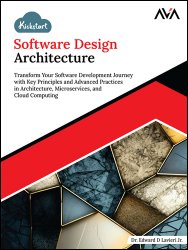Kickstart Software Design Architecture
- Добавил: literator
- Дата: 19-09-2024, 13:23
- Комментариев: 0
 Название: Kickstart Software Design Architecture: Transform Your Software Development Journey with Key Principles and Advanced Practices in Architecture, Microservices, and Cloud Computing
Название: Kickstart Software Design Architecture: Transform Your Software Development Journey with Key Principles and Advanced Practices in Architecture, Microservices, and Cloud ComputingАвтор: Edward D Lavieri Jr.
Издательство: Orange Education Pvt Ltd, AVA
Год: 2024
Страниц: 356
Язык: английский
Формат: epub (true)
Размер: 17.9 MB
Learn to design robust software systems using modern architecture principles and practical hands-on experience.
Key Features:
- Learn about fundamental software architecture concepts, including design patterns, microservices, and cloud computing.
- Bridge theory with practice through real-world examples and case studies.
- Gain expertise through an interactive and engaging learning approach, featuring coding exercises and hands-on opportunities.
Book Description:
Kickstart Software Design Architecture is designed to empower readers with a deep understanding of software architecture's critical role in successful software development. Firstly, the book offers interactive exercises, allowing readers to apply principles in real-world scenarios, thereby solidifying their understanding of how software architecture directly impacts the efficiency, scalability, and maintainability of applications. Secondly, through an extensive collection of case studies and examples, it provides industry's best practices, demonstrating the influence of well-designed software architecture on a project’s success.
Explore the ever-evolving world of software architecture. Bridge the gap between emerging technologies and foundational principles, with a comprehensive guide tailored for newcomers to the field. The book highlights the significance of software architecture in building scalable, efficient, and robust applications. The book is structured into engaging chapters, each focused on a specific aspect of software architecture. It starts with an introduction to the basics of software design patterns, gaining an understanding of their role in crafting flexible and reusable code. Next, microservices are covered, followed by chapters that focus on cloud computing, containerization, and more. Chapters contain real-world examples, hands-on exercises, and case studies, to help readers gain both foundational knowledge and hands-on experience. By the end of the book, you should have a solid foundation in software architecture and be equipped with the knowledge and skills to confidently address complex software architectural challenges.
What you will learn:
- Understand the essential principles and concepts of software architecture, including key design considerations and methodologies.
- Explore the principles of design patterns to create flexible, reusable, and maintainable code.
- Learn about the impact of different programming languages on software architecture and development, and how to choose the right language for your projects.
- Gain insight into the microservices architecture, its benefits, challenges, and best practices for implementation
This book consists of 12 chapters, each a complete module, serving as your comprehensive guide to fully understanding modern software design and architecture principles. It covers a wide array of topics, ranging from the fundamentals to advanced techniques. Whether you are a seasoned software architect looking to expand your skills or a newcomer eager to dive into software design, this book has something for everyone. Each chapter concludes with points to remember, multiple choice questions (and answers), deep thought questions, key terms, and exercises.
Chapter 1. Introduction to Software Architecture: This chapter lays the foundation for understanding the role and importance of software architecture in the software development process. It explores the historical evolution of architectural styles, from monolithic to microservices, and delves into key architectural principles and practices such as separation of concerns and modularity. Through real-world examples and interactive exercises, you can gain a comprehensive understanding of how to design scalable, maintainable, and efficient software systems.
Chapter 2. Principles of Design Patterns: This chapter introduces you to the foundational concepts of design patterns in software architecture, emphasizing their role in creating flexible and maintainable systems. It explores key design pattern categories—creational, structural, and behavioral—detailing how each can be applied to solve common software design challenges. Through examples and exercises, you can gain practical insights into implementing and leveraging design patterns to enhance your software development projects.
Chapter 3. Role of Programming Languages: This chapter explores the impact of programming languages on software design by comparing Java and Python, highlighting their unique architectural considerations, and discussing best practices for coding in each language. You can gain insights into key topics such as syntax, performance, scalability, and security, while also learning about testing, documentation, and code maintenance strategies. This chapter in designed to equip you with the knowledge to make informed decisions in selecting and utilizing programming languages effectively for modern software architecture.
Contents:
Скачать Kickstart Software Design Architecture
Внимание
Уважаемый посетитель, Вы зашли на сайт как незарегистрированный пользователь.
Мы рекомендуем Вам зарегистрироваться либо войти на сайт под своим именем.
Уважаемый посетитель, Вы зашли на сайт как незарегистрированный пользователь.
Мы рекомендуем Вам зарегистрироваться либо войти на сайт под своим именем.
Информация
Посетители, находящиеся в группе Гости, не могут оставлять комментарии к данной публикации.
Посетители, находящиеся в группе Гости, не могут оставлять комментарии к данной публикации.

